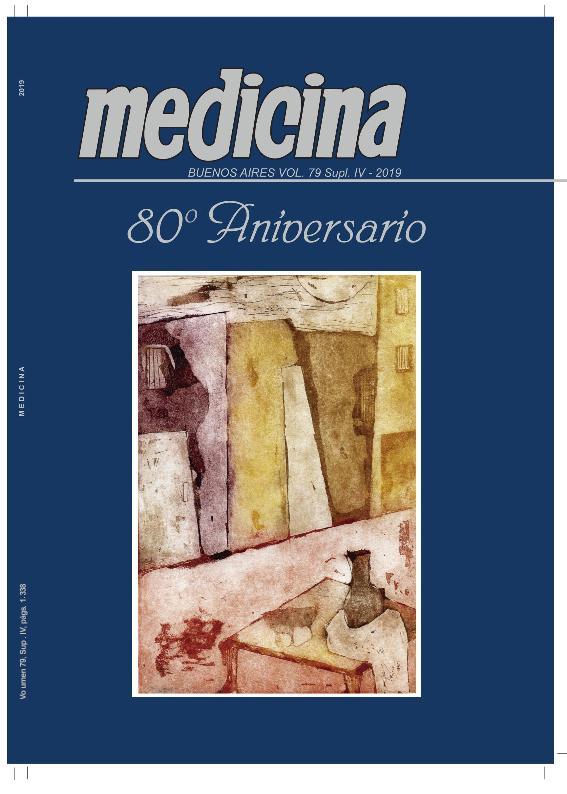Evento
Unraveling the molecular mechanism of DII, a new anthelmintic drug
Giunti, Sebastián ; Azcona, Pamela Liliana
; Azcona, Pamela Liliana ; Blanco, Maria Gabriela
; Blanco, Maria Gabriela ; Silbestri, Gustavo Fabián
; Silbestri, Gustavo Fabián ; Rayes, Diego Hernán
; Rayes, Diego Hernán ; de Rosa, Maria Jose
; de Rosa, Maria Jose
 ; Azcona, Pamela Liliana
; Azcona, Pamela Liliana ; Blanco, Maria Gabriela
; Blanco, Maria Gabriela ; Silbestri, Gustavo Fabián
; Silbestri, Gustavo Fabián ; Rayes, Diego Hernán
; Rayes, Diego Hernán ; de Rosa, Maria Jose
; de Rosa, Maria Jose
Colaboradores:
Kotsias, Basilio Aristides ; de Vito, Eduardo
; de Vito, Eduardo ; Narvaiz Kantor, Isabel; Semeniuk, Guillermo Basilio
; Narvaiz Kantor, Isabel; Semeniuk, Guillermo Basilio
 ; de Vito, Eduardo
; de Vito, Eduardo ; Narvaiz Kantor, Isabel; Semeniuk, Guillermo Basilio
; Narvaiz Kantor, Isabel; Semeniuk, Guillermo Basilio
Tipo del evento:
Reunión
Nombre del evento:
LXIV Reunión Anual de la Sociedad Argentina de Investigación Clínica ; LI Reunión Anual de la Asociación Argentina de Farmacología Experimental ; XXI Reunión Anual de la Sociedad Argentina de Biología; XXXI Reunión Anual de la Sociedad Argentina de Protozoología; IX Reunión Anual de la Asociación Argentina de Nanomedicinas; VI Reunión Científica Regional de la Asociación Argentina de Ciencia y Tecnología de Animales de Laboratorio
Fecha del evento:
13/11/2019
Institución Organizadora:
Sociedad Argentina de Investigación Clínica;
Asociación Argentina de Farmacología Experimental;
Sociedad Argentina de Biología;
Sociedad Argentina de Protozoología;
Asociación Argentina de Nanomedicinas;
Asociación Argentina de Ciencia y Tecnología de Animales de Laboratorio;
The Histochemical Society;
Título del Libro:
Libro resumenes reunion SAFE/SAIC/SAP/SAB
Título de la revista:
Medicina (Buenos Aires)
Editorial:
Fundación Revista Medicina
ISSN:
0025-7680
e-ISSN:
1669-9106
Idioma:
Inglés
Clasificación temática:
Resumen
Nematode parasites cause substantial morbidity to billions of people and considerable losses in livestock and food crops. The repertoire of effective anthelmintic compounds is very limited, as drug development has been delayed for decades. By using C. elegans as a model for parasitic nematodes, we previously identified a new imidazole derivative, diisopropylphenyl-imidazole (DII), as a promising candidate for anthelmintic agent. DII lethal effects rely on a previously unidentified muscle nicotinic receptor (AChR), different from the classical levamisole-sensitive AChR. This novel AChR is composed by UNC-29 (a non-alpha subunit incapable of forming homomeric receptors) and other unidentified subunits. To elucidate its stoichiometry, we performed an initial screening of strains containing null mutations in different AChR subunits. By exposing these animals to DII (600 m), we found a null mutant in acr-23 (an alpha nicotinic subunit) that is even more resistant to DII than UNC-29 null mutants. Since the mutants used in the initial screening had not been outcrossed to the wild-type (wt), we performed this outcross four times, selecting (by genotyping) those animals that contain the deletion in acr-23. Surprisingly, these outcrossed animals are as sensitive to DII as the wt. Moreover, when we outcrossed the original mutant strain to the wt selecting by their resistance to DII, we obtained animals that contain wild-type acr-23 alleles. This strongly suggests that another mutation, different from acr-23 deletion, causes the DII resistance. The drug resistance of these mutants appears to be DII-specific, as it is as sensitive to the classic anthelmintic levamisole as the wt. We are now focused on determining the gene that underlies this DII resistant phenotype. Parasite resistance to traditional nematocidal drugs has become a global concern. Therefore, the identification of new anthelmintics with novel targets, as DII, is mandatory to circumvent this growing problem.
Palabras clave:
C. elegans
,
AChR
,
Target
,
Nematicide
Archivos asociados
Licencia
Identificadores
Colecciones
Eventos(INIBIBB)
Eventos de INST.DE INVEST.BIOQUIMICAS BAHIA BLANCA (I)
Eventos de INST.DE INVEST.BIOQUIMICAS BAHIA BLANCA (I)
Eventos(INQUISUR)
Eventos de INST.DE QUIMICA DEL SUR
Eventos de INST.DE QUIMICA DEL SUR
Citación
Unraveling the molecular mechanism of DII, a new anthelmintic drug; LXIV Reunión Anual de la Sociedad Argentina de Investigación Clínica ; LI Reunión Anual de la Asociación Argentina de Farmacología Experimental ; XXI Reunión Anual de la Sociedad Argentina de Biología; XXXI Reunión Anual de la Sociedad Argentina de Protozoología; IX Reunión Anual de la Asociación Argentina de Nanomedicinas; VI Reunión Científica Regional de la Asociación Argentina de Ciencia y Tecnología de Animales de Laboratorio; Mar Del Plata; Argentina; 2019; 209-209
Compartir



